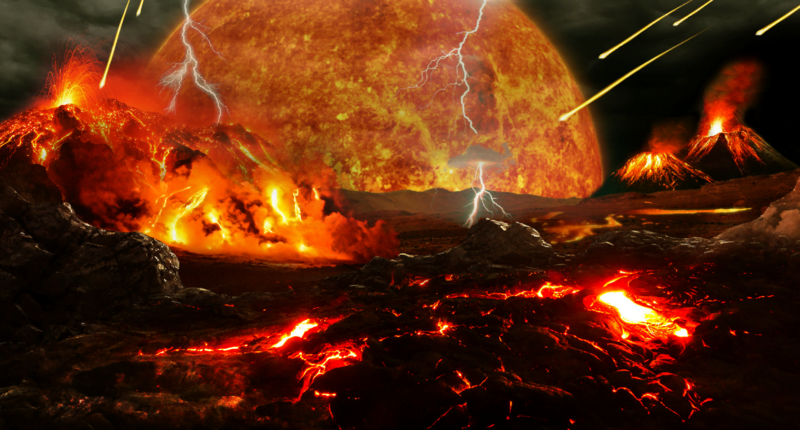4.5 billion years ago Hadean- The age of Elementals

The planet Earth forms with all Elementals vying for supremacy.
Bound by gravity, the leftover stardust from the Sun’s creation formed the rest of the planets in our solar system. The inner solar system was a violent and crowded place during which the Earth was repeatedly pelted with rocks from outer space. The surface was young and volatile with massive gates to all the elemental planes wide open, each spewing tones of raw elemental matter.
Highlights of the Hadean
- Chaos gives birth to Gaia
- Formation of the Moon
- Meteoric bombardment
- Emergence of plate tectonics and continents (From the elemental planes of Earth and Fire)
- Formation of the first and second atmospheres (From the Elemental Plane of Air)
- Creation of the oceans (From the elemental plane of water)
- Cthugha and its fire vampires arrive on the Earth as it cools.
The Hadean aeon is largely characterized by a period known as the Late Heavy Bombardment, during which the young Earth and moon experienced countless impact events. Since the inner solar system was so crowded during these far-off times, the surface was constantly bombarded by asteroids.
The proto-Earth grew by by the gradual accumulation of additional matter each impact adding to its momentum until its interior was superhot causing most heavy metals to sink to its core . This so-called iron catastrophe resulted in the separation of a primitive mantle and a (metallic) core only 10 million years after the Earth began to form, producing the layered structure of Earth and setting up the formation of Earth’s magnetic field.
Temperatures are extremely hot, with frequent volcanic activity and hellish environments. The atmosphere is nebular. The early oceans are bodies of ever changing molten liquid.
The Moon was formed by a colossal impact event between the young Earth and a Mars-sized planet, often dubbed ‘Theia’.
Land Masses Rise from the Magmatic Ocean
The early stages of the Late Heavy Bombardment ended as the Sun evolved to become the main-sequence star that we see today. The solar wind helped to clear Earth’s orbit of dust and gas and the violent birth of the solar system gave way to a relatively calmer period that pervades to this day. As the dust settled and the apocalypse drew to an end, the surface started to cool enough for continents to form. Out of the fiery depths of what is now the mantle, a solid crust formed and, finally, our world had a surface that you could stand on.
The first oceans on Earth also formed during the Hadean aeon.

 Buy me a coffee
Buy me a coffee